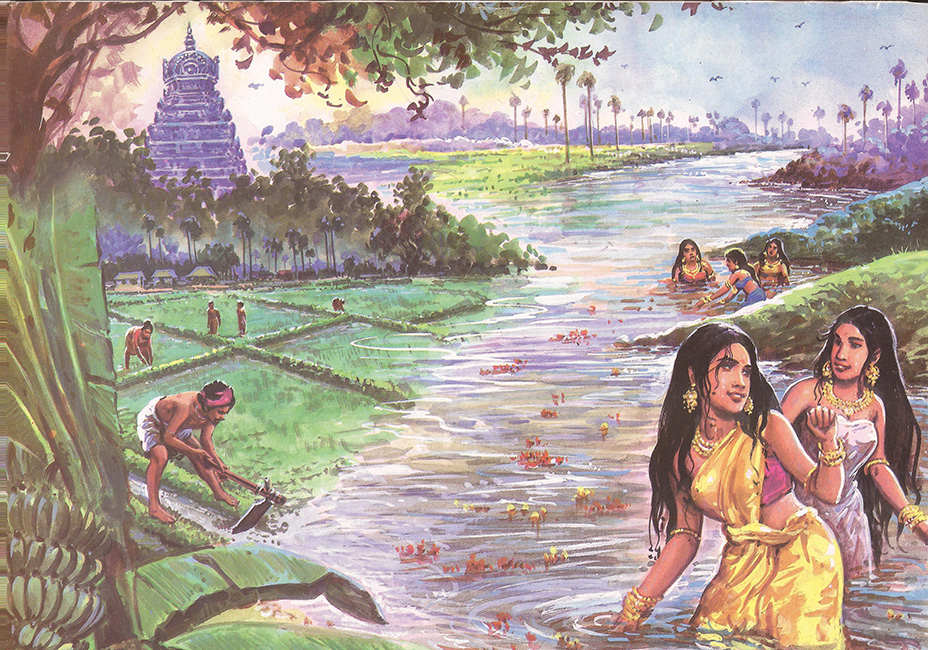Deepa Bhasthi delves into the world of Sangam poetry – the surroundings in which they were written, the traditions they had to adhere to, and emotions they elicited.
I cannot name my lover here. Tradition will not allow me to. Not when these are poems from the Sangam era that I write about here. ‘Poetry cannot swerve from tradition,’ declares the Tholkappiyam, the definitive text on Tamil grammar written, scholars say variously, between 3rd century BCE and 3rd century CE.
My poetry, I am the Sangam era, has to adhere to strict rules that the rest of the few hundred poets who wrote me worked with. I can speak only anonymously. I cannot tell you my name, not my mother’s, not my female companion’s. My lover’s name I cannot bring to my lips, I can only say how,
Gently he would stroke
my long and curly hair
and put his arms around me.
We cannot tell you our names. We can tell you were we are from though. That place you now call Madurai, the city of lady Meenakshi, used to house a Sangam, an academy, where hundreds, some say thousands, of poets lived and wrote my poetry. There were two other sangams, according to tradition, one south of the present-day Kanyakumari and the other in Kapadapuram. Both were submerged, there is a historical memory of a massive tsunami that destroyed thousands of poems. The two thousand that survived are from the third sangam.
Near Madurai, the river Vaiyai (also called Vaigai) once used to be a mighty river. So important was the river, that the people of Madurai, then under the Pandiyan kings, revered it, constructed songs in praise of its waters. The Paripatal, the last of the eight anthologies that make up part of the eighteen greater anthologies of the corpus of Sangam/Cankam literature, contains songs for the river. These are the only texts in the Sangam literature that are written according to melodic scale, called pan, so scholars believe that they were set to music and performed. In the Paripatal, Vaiyai is ‘known in the most immediate manner, through the senses’, the flow and ebb of the river is akin to the hero’s love for the heroine.
He goes away often, my lover. Chasing wealth, fame and other women. I pine, in the inky darkness of the night, I wait. Yet,
In the hillman’s mountain fields
where the millet harvest is over
the lush country beans
have started blooming.
Even in this cold winter
He hasn’t come home.
He comes home, my lover and we meet,
…in the woods by the
seashore
where the hoary sea
plays on the beach
and the birds are clamorous
***
I would never swim in the
Vaiyai
with anyone other than
you.
I told my lover this. To the mighty Vaiyai, our people
…feed the river
garlands, pastes,
musks and
ornaments,
making the waters
beautiful.
They offer the
river liquor,
which it refuses to
drink.
The river was where we bathed. He would lay his eyes on the other women who came to bathe there, the kind whose,
Garlands of leaves mix
with hair, rubbing paste on
bodies,
erasing it away
in the embrace:
jewels on breasts and
chests,
tangled, entwined.
The poems the poets wrote then, they were of the Marutam thinai, the countryside and plains that set the scene for my man’s infidelity. They constructed five thinais, each named after a flower, representing a geographical region, each indicative of a set of feelings in the poems as well.
My lover, he always brought me flowers, withered sometimes from the long journey and protested his innocence. My companions would tease, set up ruses. We would meet at the Vaiyai.
With a laugh, he goes
away, taking her
along,
like a river rushing to
join the immense,
dark ocean.
Not drinking the fruit
liquor,
nor wiping away the
blood-red water,
he makes love to
her.
Her friends say,
‘She is blossoming,
may she live long,
and prosper.’
The Vaiyai makes her
blush.
My eyes, laced with collyrium, would be red, because
of
palm liquor
flowing water
lovemaking.
I forgive him, for I am the virtuous, not the other woman. He is a man, after all, and
Mixing love and
liquor,
bringing together
lover and beloved
to bathe and make
love:
this is the nature of
Vaiyai,
full of flowers.
HIM
I cannot tell you the name of my lover. Tradition does not allow me to. The poets who wrote of our love stories, of the river Vaiyai, of the frolicking we indulged in, of our flowers, our longing in separation, the urgency, desires in our lovemaking, these poets of extraordinary genius, they only tell you who said what to whom.
When,
I think of the sweet embraces
of my girl,
her tender, rounded arms
and her golden spotted breasts.
The poets will tell you that I was pining for my lover and saying this to myself. They would never speak in their individual voices. Their words were always through characters, as though it were a play. Their words were of me, the hero and my lover, the heroine. Their words were of my friend, her friend, her biological and foster mothers, my concubine and sometimes, those of my charioteer. This anonymity is why their words appeal to you now, communicating across time and space in this modern century. They do not seem like the words of my time, of two millennia ago when I lived and loved my women.
The subjects of love that these poets wrote on, about our love lives, these are divided into the complementary categories of akam and puram, both extraordinarily complex and defying any simple explanation. Akam is inside, heart, mind, sexual pleasure, breast, etc. Puram is the ‘other’ of akam: outside, exterior, bravery, side, back, gossip, wild tract, etc. From our times to when you are reading this now, hundreds of words have been described as either of these two concepts. It is complicated. Our lives were of simpler times though. We loved and laughed, revered the river, prayed to our gods, paid allegiance to our kings of the Pandiya dynasty.
It was a woman’s world that the poets wrote of. It is my lover’s feelings that the Vaiyai best carries in her swelling waters. They sometimes talk of that time when I had to go away, and was separated from my beautiful girl.
If one can make out
morning and day,
desolate evenings
and night when the world
sleeps,
and daybreak,
then this love is false.
To ride the palm-frond horse
and be mocked on the street
is a shame.
So is living
in separation.
She, my lover,
I met her in the foothills
rich with flowers —
a slim young girl
with broad shoulders.
The water of her gracefulness
has subdued the fire
of my manliness.
***
this beautiful young girl
with sparkling white teeth
and bangled wrists
has struck me down.
***
I do not know
if she knows it or not,
but my heart is still with her
and I lie here
heaving heavy sighs
like a sleeping elephant.
I have been with other women. There are concubines. Yet my lover became my son’s mother. I always return to her. For how could I ever forget, in this life, and in yours as you read this, my son’s mother,
Wearing an amulet
made of the forked
leaves,
which have dull
undersides,
of the soft-flowered vagai
and leaves of arugu,
…
and the sweet-smelling
buds of pavai,
that sprouted in the first
monsoon rain
that came like thunder,
whose petals of blue
resemble
neatly washed sapphire
stones,
bound together with a
white thread,
she looked resplendent
and lovable
in her wedding dress.
_______________________________________________________________________________________________________________
Note:
All the lines in italics are extracts from Sangam poetry, written between 300 BCE and 300 CE. I have taken these poems and several references from two books.
- Love Stands Alone: Selections from Tamil Sangam Poetry, edited by A R Venkatachalapathy
- The River Speaks: The Vaiyai Poems from the Paripatal, translated by V N Muthukumar and Elizabeth Rani Segran














